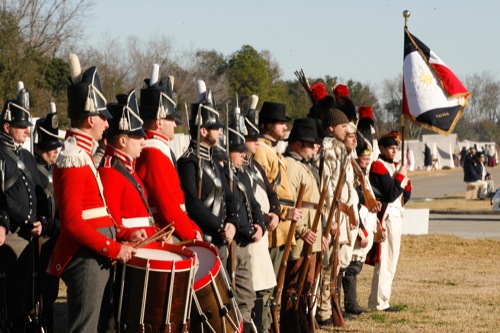
Jean Lafitte National Historical Park, courtesy NPS
Even if you had trouble paying attention in your high school history class, you won’t be distracted while listening to a National Park ranger fervently bring to life the bravery, the fear and the bloodshed that took place on the battlegrounds where you now stand.
Those who have had the experience while on a tour agree: The passionate employees at this country’s national military parks are rock stars in the history world.
While those battlefields are great visitor destinations, much more important are the gripping tales that make them so important. Eloquent and dedicated park specialists offer educational programs and guided tours that make America’s battlefields memorable.
Chalmette Battlefield at Jean Lafitte National Historical Park
Chalmette, Louisiana
Just downriver from New Orleans in Chalmette is the site of the 1815 Battle of New Orleans: Chalmette Battlefield.
“This was the last great battle of the War of 1812 between the United States and Britain,” said park ranger Kristy Wallish. “With a levee and woods, it looks much like it would have looked when Andrew Jackson forced the British to funnel through a narrow expanse, forcing the British to walk toward his guns — and it worked.
“Our visitors center, with films, uniforms, displays and weapons, is designed to get a gist of what happened.”
Wallish added that on January 8 an annual living history event explains in detail the tactics of battles during the era.
“We discuss all those things we don’t understand,” she said. “How did they communicate? Why did they walk towards guns — such a counter-intuitive thing to do?
“This battle represented the true American spirit. The British thought no one down here — people of color, the French and even volunteers — would work as a team and fight together, but they did. The thought was, ‘We’re all Americans!’”
www.nps.gov/jela/chalmette-battlefield.htm
Minute Man National Historical Park
Concord, Massachusetts
On April 19, 1775, “the shot heard round the world” was fired at Lexington Green and was followed by fighting at Concord’s North Bridge and on the road back to Boston. Thus began a war for independence that lasted more than eight years: the American Revolution.
The culmination of a decade-long political feud between the British government and the American colonists, the story of Minute Man National Historic Park is more than just the events that took place, according to park ranger Roger Fuller.
“The story includes ideals of freedom and liberty and today continues to serve as an inspiration around the world,” Fuller said.
The park’s visitors center includes “the porthole to the park, the multiaward-winning film ‘Road to Revolution,’” according to Fuller.
“We know the ending of the story, but the colonists did not. Throughout, colonists — farmers and just regular people — were given orders to shoot at British troops. This is like us shooting at our government officials today. Why did they do it? Why did they not run and go home? Surely you were risking not only your life but your future if you survived.”
The center also has exhibits that detail the role of minorities in the battle.
A drive through this 1,000-acre park showcases buildings and sites in Lexington, Lincoln and Concord that were part of the battle. At North Bridge, a living-history center called Heartwell Tavern depicts life in 1775. Regular programs take place throughout the summer and fall seasons during which visitors enjoy firing of muskets and more. Consider visiting on April 19 — Patriot’s Day in Massachusetts — when costumed re-enactors offer multiple points of view during the conflict.









